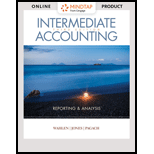
INTERM.ACCT.:REPORTING...-CENGAGENOWV2
3rd Edition
ISBN: 9781337909358
Author: WAHLEN
Publisher: CENGAGE L
expand_more
expand_more
format_list_bulleted
Concept explainers
Question
Chapter 19, Problem 8E
To determine
Prepare necessary journal entries of Company F for 2019.
Expert Solution & Answer
Trending nowThis is a popular solution!

Students have asked these similar questions
I am trying to find the accurate solution to this general accounting problem with the correct explanation.
Can you help me solve this general accounting question using the correct accounting procedures?
I need help finding the correct solution to this financial accounting problem with valid methods.
Chapter 19 Solutions
INTERM.ACCT.:REPORTING...-CENGAGENOWV2
Ch. 19 - Prob. 1GICh. 19 - Prob. 2GICh. 19 - Prob. 3GICh. 19 - Prob. 4GICh. 19 - Prob. 5GICh. 19 - Prob. 6GICh. 19 - Prob. 7GICh. 19 - Prob. 8GICh. 19 - Prob. 9GICh. 19 - Prob. 10GI
Ch. 19 - Prob. 11GICh. 19 - Prob. 12GICh. 19 - Prob. 13GICh. 19 - Prob. 14GICh. 19 - Prob. 15GICh. 19 - Prob. 16GICh. 19 - Prob. 17GICh. 19 - Prob. 18GICh. 19 - Prob. 19GICh. 19 - Prob. 20GICh. 19 - Prob. 21GICh. 19 - Prob. 22GICh. 19 - Prob. 23GICh. 19 - The actuarial present value of all the benefits...Ch. 19 - Prob. 2MCCh. 19 - Prob. 3MCCh. 19 - Prob. 4MCCh. 19 - Prob. 5MCCh. 19 - Prob. 6MCCh. 19 - Which of the following is not a component of...Ch. 19 - Prob. 8MCCh. 19 - Prob. 9MCCh. 19 - Prob. 10MCCh. 19 - Prob. 1RECh. 19 - Prob. 2RECh. 19 - Pinecone Company has plan assets of 500,000 at the...Ch. 19 - Prob. 4RECh. 19 - Prob. 5RECh. 19 - Prob. 6RECh. 19 - Prob. 7RECh. 19 - Prob. 8RECh. 19 - Given the following information for Tyler Companys...Ch. 19 - At the beginning of Year 1, Cactus Company has...Ch. 19 - Prob. 11RECh. 19 - Prob. 1ECh. 19 - Prob. 2ECh. 19 - Prob. 3ECh. 19 - Prob. 4ECh. 19 - Prob. 5ECh. 19 - Prob. 6ECh. 19 - Prob. 7ECh. 19 - Prob. 8ECh. 19 - Prob. 9ECh. 19 - Prob. 10ECh. 19 - Prob. 11ECh. 19 - Prob. 12ECh. 19 - Prob. 13ECh. 19 - Refer to the information provided in E19-13....Ch. 19 - Prob. 15ECh. 19 - Prob. 16ECh. 19 - Prob. 1PCh. 19 - Prob. 2PCh. 19 - Prob. 3PCh. 19 - Prob. 4PCh. 19 - Prob. 5PCh. 19 - Prob. 6PCh. 19 - Prob. 7PCh. 19 - Prob. 8PCh. 19 - Prob. 9PCh. 19 - Prob. 10PCh. 19 - Prob. 11PCh. 19 - Prob. 12PCh. 19 - Prob. 1CCh. 19 - Prob. 2CCh. 19 - Prob. 3CCh. 19 - Prob. 4CCh. 19 - Prob. 5CCh. 19 - Prob. 6CCh. 19 - Prob. 7CCh. 19 - Prob. 9C
Knowledge Booster
Learn more about
Need a deep-dive on the concept behind this application? Look no further. Learn more about this topic, accounting and related others by exploring similar questions and additional content below.Similar questions
- I need help with this general accounting problem using proper accounting guidelines.arrow_forwardI am trying to find the accurate solution to this general accounting problem with appropriate explanations.arrow_forwardCan you guide me through solving this financial accounting problem using proper techniques?arrow_forward
arrow_back_ios
SEE MORE QUESTIONS
arrow_forward_ios
Recommended textbooks for you
 Intermediate Accounting: Reporting And AnalysisAccountingISBN:9781337788281Author:James M. Wahlen, Jefferson P. Jones, Donald PagachPublisher:Cengage Learning
Intermediate Accounting: Reporting And AnalysisAccountingISBN:9781337788281Author:James M. Wahlen, Jefferson P. Jones, Donald PagachPublisher:Cengage Learning Individual Income TaxesAccountingISBN:9780357109731Author:HoffmanPublisher:CENGAGE LEARNING - CONSIGNMENT
Individual Income TaxesAccountingISBN:9780357109731Author:HoffmanPublisher:CENGAGE LEARNING - CONSIGNMENT

Intermediate Accounting: Reporting And Analysis
Accounting
ISBN:9781337788281
Author:James M. Wahlen, Jefferson P. Jones, Donald Pagach
Publisher:Cengage Learning


Individual Income Taxes
Accounting
ISBN:9780357109731
Author:Hoffman
Publisher:CENGAGE LEARNING - CONSIGNMENT
